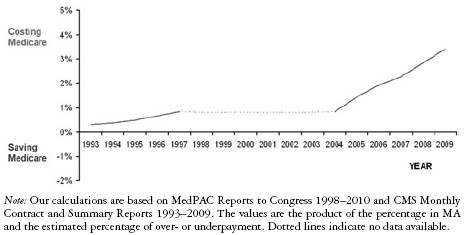“An Economic History of Medicare Part C,” a new paper in The Milbank Quarterly by McGuire, Newhouse, and Sinaiko, is a tasty smorgasbord of background on Medicare Advantage, aka Medicare Part C.* I mean no disrespect for the authors or their work, but let’s just skip all the very nice detail in the paper and cut right to the money chart that illustrates the net effect of the Medicare Advantage program on Medicare spending:
Clearly this figure shows us very little about what happened between 1997 and 2004. Feel free to presume that the program saved Medicare so much money in those years that it offset the documented massive costs in other years, but I doubt you’d find many serious scholars agreeing with you. No, on the whole, the program has cost us and cost us dearly.
This need not be a condemnation of private plans, but it isn’t good news for pro-market advocates. Were I to don that hat, and I have done so, I’d be infuriated or embarrassed by this abysmal performance of MA plans. As a taxpayer, I’m none too happy. There’s a rather simple way to address it without abandoning the MA program, as I suspect would be hard for Congress to achieve. Until we force private plans to compete head-on with traditional Medicare, I’m afraid we’ll see more overpayments of the type documented in the chart.
A potential silver lining would be that all the extra spending on MA led to a spillover that, somehow, saved at least as much in traditional Medicare. If that were once true, it is not likely to be so today.
* The paper is gated, but you can find a current summary of the Medicare Advantage program at the Robert Wood Johnson Foundation.



